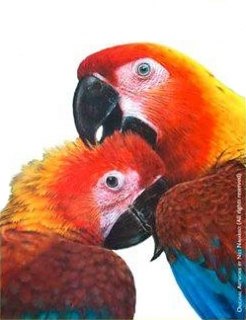Cuban Macaw |
|
|
Photos
View in GalleryDid You Know?
There are nineteen specimens of the Cuban Macaw in 15 museums in Cuba, Europe and the US.Academic Research
Related publications: Ara tricolorSpecies Profile
Genus: Ara | Species: tricolor
Size:
50 cm
Weight:
Not recorded.
Subspecies including nominate:
one
Colour Adult:
Red and orange wash on face, crown and throat, deep yellow on neck. Crimson wing-coverts, blue primary wing feathers. White face, large black bill. Legs and feet slate grey. Upper tail and vent scarlet, mid-tail to tip blue.
Colour Juvenile:
Not recorded.
Call:
Was described as similar to macaws in C America.
More Information:
Avibase
IUCN Red List
Zoological Museum Amsterdam Bird Collection
Content Sources:
BirdLife International
Vanished and Vanishing Parrots, Forshaw, 2017.
Photos
View in GalleryDid You Know?
There are nineteen specimens of the Cuban Macaw in 15 museums in Cuba, Europe and the US.Academic Research
Related publications: Ara tricolorSpecies Care
Captive Status:
Not recorded.
Longevity:
Not recorded.
Housing:
Not recorded.
Diet:
Not recorded.
Enrichment:
Not recorded.
Nest Box Size:
Not recorded.
Clutch Size:
Not recorded.
Incubation Time:
Not recorded.
Fledging Age:
Not recorded.
Hatch Weight:
Not recorded.
Peak Weight:
Not recorded.
Weaning Weight:
Not recorded.
Photos
View in GalleryDid You Know?
There are nineteen specimens of the Cuban Macaw in 15 museums in Cuba, Europe and the US.Academic Research
Related publications: Ara tricolorSpecies Wild Status
World Population:
None
IUCN Red List Status:
Extinct
CITES Listing:
Not listed.
Threat Summary:
Were trapped for wild bird trade and hunted for food.
Range:
Formerly Cuba, probably included Isla de Pinos and possibly Hispaniola.
Habitat:
Were reported from lowland savanna, including coastal regions, and interior forests at low elevations. They frequented open areas with scattered trees, particularly with palms.
Wild Diet:
Recorded food items include fruits, seeds of introduced Chinaberry trees Melia azedarach, and shoots and buds. May also have fed on palm nuts.
Ecology and Behaviour:
Birds are said to have occurred in pairs and family groups. The ease with which they were captured or shot suggest that they were confiding, like other Caribbean macaws.
Clutch and Egg Size:
Not recorded.
Breeding Season:
Nests were apparently in palm tree cavities.
Related Links:
Photos
View in GalleryDid You Know?
There are nineteen specimens of the Cuban Macaw in 15 museums in Cuba, Europe and the US.Academic Research
Related publications: Ara tricolorMembers Only Resources
Please log-in now to find more research, resources and tools.
Not a Member?
Find more great information:
Gain exclusive access to 600+ pages of additional research, seminars and podcasts, specialists to ask your toughest questions, and dozens of other fun resources - when you become a WPT member.
Join Today >>

































